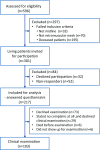Long-Term Follow-Up of Retromuscular Incisional Hernia Repairs: Recurrence and Quality of Life
- PMID: 29018922
- PMCID: PMC5843679
- DOI: 10.1007/s00268-017-4268-0
Long-Term Follow-Up of Retromuscular Incisional Hernia Repairs: Recurrence and Quality of Life
Abstract
Purpose: Incisional hernia repair (IHR) with a mesh is necessary to achieve low recurrence rates and pain relief. In the short term, quality of life (QoL) is restored by IHR. Two centers pioneered the IHR in Sweden with the highly standardized Rives-Stoppa technique using a retromuscular mesh. We assessed long-term follow-up of recurrence rate and QoL.
Methods: Medical records were searched for IHRs performed from 1998 to 2006 and included living patients with midline repairs. Questionnaires about physical status, complaints, and QoL (SF-36) were mailed, offering a clinical examination. Assessment of medical records of later surgery was performed in 2015.
Results: Three hundred and one patients with midline incisional repairs were identified, and 217 accepted participation. Of these, 103 attended a clinical examination. Follow-up was 7 years until examination and 11 years to reassessment of medical records. In 26%, recurrent hernias were repaired. Postoperative complications were 26% Clavien-Dindo grade I-II and 1% grade III-IV. Mesh infections occurred in 1.4% without mesh removals, and 4% were reoperated because of complications. Overall recurrence rate was 8.1% and two-third of which were diagnosed at clinical examination. Recurrence after primary and recurrent hernia repair was 7.1 and 10.9%, respectively. Of all patients, 80% were satisfied; dissatisfaction was primarily caused by recurrence and chronic pain. SF-36 scores were 0.2 SD lower than the norm in all subscales, similar to those with 1-2 chronic conditions.
Conclusions: Midline retromuscular mesh IHR has a low long-term recurrence rate even after recurrent repair. Patient satisfaction was high although QoL was reduced.
Conflict of interest statement
The authors declare no conflict of interest.
Figures


Comment in
-
Long-Term Follow-Up of Retromuscular Incisional Hernia Repairs: Recurrence and Quality of Life.World J Surg. 2018 Aug;42(8):2682-2683. doi: 10.1007/s00268-017-4377-9. World J Surg. 2018. PMID: 29134316 No abstract available.
-
Long-Term Follow-Up of Retromuscular Incisional Hernia Repairs: Recurrence and Quality of Life: Reply.World J Surg. 2018 Aug;42(8):2684-2685. doi: 10.1007/s00268-018-4472-6. World J Surg. 2018. PMID: 29352334 No abstract available.
References
-
- Bosanquet DC, Ansell J, Abdelrahman T, Cornish J, Harries R, Stimpson A, Davies L, Glasbey JC, Frewer KA, Frewer NC, Russell D, Russell I, Torkington J. Systematic review and meta-regression of factors affecting midline incisional hernia rates: analysis of 14,618 patients. PLoS ONE. 2015;10(9):e0138745. doi: 10.1371/journal.pone.0138745. - DOI - PMC - PubMed
-
- Hawn MT, Snyder CW, Graham LA, Gray SH, Finan KR, Vick CC (2010) Long-term follow-up of technical outcomes for incisional hernia repair. J Am Coll Surg 210(5):648–655 discussion 655–657. doi:10.1016/j.jamcollsurg.2009.12.038 - PubMed
Publication types
MeSH terms
LinkOut - more resources
Full Text Sources
Other Literature Sources

